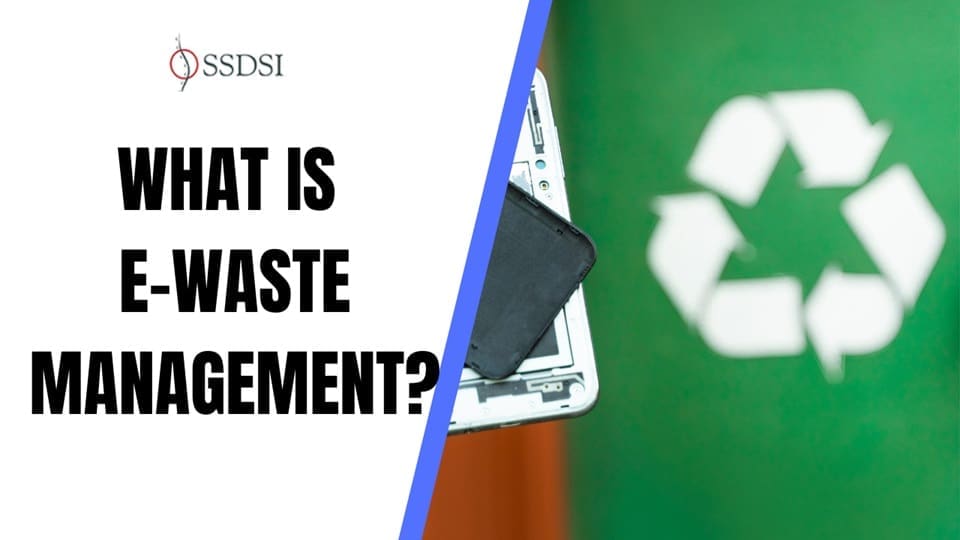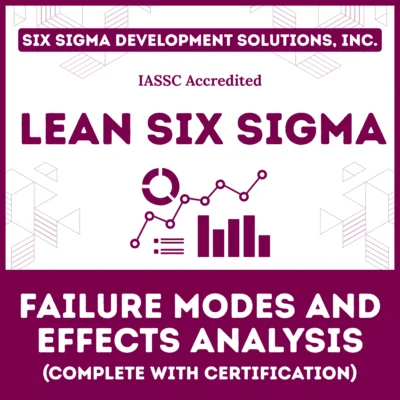E-waste management refers to the handling of discarded electrical or electronic devices. This includes a wide range of items, from household appliances like refrigerators and televisions to smaller electronics such as computers, smartphones, and tablets.
E-waste is not only a growing problem in developed nations but also in developing countries where most of it ends up. Countries like India, China, and many in Africa have become the primary destinations for the disposal of e-waste from developed countries.
Improper recycling of e-waste has created devastating consequences for both human health and the environment.
Table of contents
What is E-waste Management?
E-waste management refers to the process of collecting, recycling, and disposing of electronic waste (e-waste) in an environmentally responsible way.
As technology continues to evolve, old electronic devices, such as computers, mobile phones, televisions, and refrigerators, quickly become obsolete. Improper disposal of these devices can lead to environmental damage and pose health risks due to the toxic substances they contain.
Public, Onsite, Virtual, and Online Six Sigma Certification Training!
- We are accredited by the IASSC.
- Live Public Training at 52 Sites.
- Live Virtual Training.
- Onsite Training (at your organization).
- Interactive Online (self-paced) training,
Key Steps in E-Waste Management
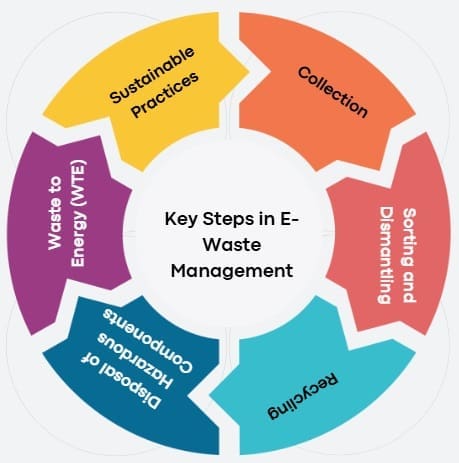
Collection:
Households, businesses, and recycling centers gather e-waste. In this step, collectors properly gather devices that have reached the end of their life cycle.
Sorting and Dismantling:
Workers sort e-waste into categories based on components and materials. This process separates valuable materials—such as metals (gold, silver, copper), plastics, and glass—from hazardous components. Technicians carefully dismantle devices like computers and mobile phones to recover precious materials.
Recycling:
Specialized facilities recycle the recovered materials. This process reduces the need for raw resources and lowers environmental impact. For example, manufacturers extract and reuse metals like copper, aluminum, and gold to produce new electronics.
Disposal of Hazardous Components:
Specialized facilities handle and dispose of harmful substances—like lead, mercury, and cadmium—found in electronic devices. These facilities ensure safe treatment and containment to prevent pollution and protect human health.
Waste to Energy (WTE):
Operators use parts of non-recyclable e-waste for energy recovery through incineration or pyrolysis. These methods reduce waste volume and generate energy, but technicians must manage them carefully to prevent the release of harmful gases.
Sustainable Practices:
E-waste managers implement environmentally friendly practices by reducing e-waste generation, promoting repair and reuse, and encouraging manufacturers to design recyclable products with fewer toxic materials.
Proper e-waste management minimizes environmental damage, conserves resources, and protects public health. Governments, businesses, and consumers must work together to ensure safe and responsible recycling of electronic devices.
Need for Sustainable E-Waste Management
Managing e-waste in a sustainable way is essential to minimize its negative impact. E-waste recycling helps recover valuable materials like gold, copper, and rare earth metals. These materials are used in manufacturing new devices, reducing the need for mining and extracting raw materials. Sustainable e-waste management can also reduce greenhouse gas emissions, save energy, and cut down on landfilling.
Recycling e-waste properly also reduces the environmental footprint of electronic devices. For example, recycling a mobile phone uses significantly less energy than mining for the metals needed to make new phones. Proper disposal of e-waste reduces the need for new landfill sites and repurposes the land for other beneficial uses.
Why E-Waste is a Problem?
The rapid growth of technology has made e-waste management an urgent issue. As electronic devices become obsolete, they contribute to increasing volumes of waste. This is particularly problematic because many electronic devices contain harmful substances like mercury, lead, and cadmium, which can contaminate the environment and pose serious health risks if not handled properly.
Developed countries often export e-waste to developing nations, where workers manually dismantle it—frequently under unsafe conditions. The lack of proper recycling infrastructure in many parts of the world makes it challenging to manage e-waste responsibly.
Also Read: What is E-waste?
Toxic Effects of E-Waste
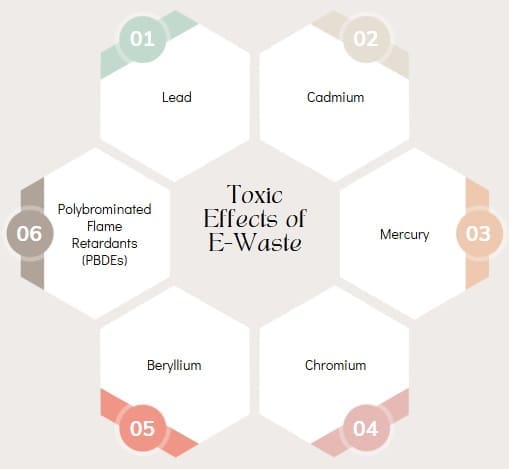
E-waste contains several hazardous substances, many of which can cause serious health problems when exposed to humans or the environment. The most concerning toxic substances include:
- Lead: Found in the glass of monitors and in soldering materials. Lead poisoning can cause damage to the brain, kidneys, and nervous system.
- Cadmium: Found in batteries, semiconductors, and other electronic parts. It is highly toxic and can cause severe health problems, including kidney damage and cancer.
- Mercury: Used in light bulbs, thermometers, and some batteries. Mercury exposure can damage the brain, kidneys, and nervous system.
- Chromium: Found in some computer parts and used for corrosion protection. It can lead to lung cancer and damage the respiratory system.
- Beryllium: Present in motherboards and electronic components. It is a carcinogen and can cause lung cancer.
- Polybrominated Flame Retardants (PBDEs): Used in plastics for circuit boards and casings. These chemicals can cause hormonal disruptions and are associated with various health problems.
When e-waste is improperly disposed of, it can leach these toxic materials into the soil and water. These substances can then enter the food chain, causing long-term harm to ecosystems and human health.
E-Waste Recycling Methods
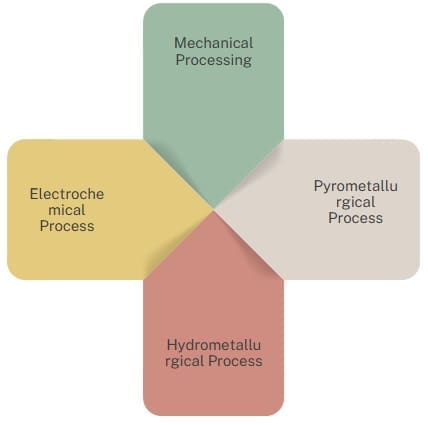
E-waste recycling involves breaking down and processing old electronic devices to recover valuable materials like metals, plastics, and glass.
- Mechanical Processing: This is the initial step in e-waste recycling, where devices are shredded or crushed to separate different materials.
- Pyrometallurgical Process: In this process, high temperatures are used to melt down metals and recover valuable elements like gold, copper, and silver.
- Hydrometallurgical Process: This process uses chemical solutions to dissolve metals from e-waste and then extract them.
- Electrochemical Process: This method involves using electrical currents to separate and recover metals from electronic waste.
Despite these processes, many regions—especially in developing countries—still recycle e-waste using unsafe and hazardous methods. Informal sector workers often handle toxic chemicals and heavy metals without proper protective equipment, putting their health at serious risk.
Also Read: What is Planned Obsolescence?
Dismantling Process
Dismantling refers to the systematic process of breaking down electronic devices into their individual components. This process is typically done using simple tools such as screwdrivers, hammers, and air drivers. The goal is to separate materials like plastics, metals, and circuit boards into different categories, making it easier to recycle or dispose of them properly.
For example:
- Computer Cases: These are disassembled manually to separate materials such as iron, aluminum, plastic, and copper.
- Cathode Ray Tube Monitors: Manufacturers use different types of glass, including leaded glass, to make these monitors, which makes recycling difficult and expensive.
- LCD Monitors: These monitors contain components like CCFL tubes, which may have mercury, and the glass panels require special handling.
Pre-Processing of E-Waste
After dismantling, e-waste often undergoes pre-processing, which involves shredding, grinding, and separating materials. During this phase, metals and non-metals are separated using various techniques like magnetic, eddy current, and density separation. Pre-processing makes it easier to recycle materials, but it also presents challenges, such as unselective blending of different materials, which can reduce the recovery rate of valuable metals.
Common pre-processing techniques include:
- Shredding and Grinding: Breaking down e-waste into smaller pieces.
- Thermal Treatment: Using heat to break down materials.
- Pyrolysis and Incineration: Using high temperatures to decompose certain materials.
- Pulverizing: Reducing materials into fine particles.
- Compressing: Compacting materials to reduce their volume.
Recovery and Refining Process
Once e-waste has been dismantled and pre-processed, the next step is to recover valuable materials like metals and plastics. This process requires specialized facilities depending on the type of materials involved.
- Precious Metals Recovery: Recyclers send high-grade circuit boards containing valuable metals like gold, silver, and palladium to facilities that specialize in hydrometallurgical processes to recover these metals.
- Lower-Grade Materials: Other materials, such as lower-grade PCBs or metals with less valuable content, may be sent to pyrometallurgical facilities, which use heat to recover metals.
Steps in E-Waste Recycling

E-waste recycling is a multi-step process. It involves:
- Collection: The first step is to gather discarded electronic devices from consumers, businesses, and other sources.
- Sorting and Dismantling: This involves separating the components of the devices and dismantling them for easier processing.
- Pre-Processing: This step includes mechanical processes like shredding and separating valuable metals from other materials.
- End Processing: This involves refining and extracting metals and other valuable materials for reuse.
Each of these steps must be carried out carefully to avoid environmental contamination and to recover as many valuable materials as possible.
Also Read: 10 Proven Waste Reduction Strategies for a Greener Tomorrow
Importance of Recycling E-Waste
Recycling e-waste is critical for several reasons:
- Conservation of Resources: Many electronic devices contain valuable metals, such as gold, silver, and copper, which can be reused to make new products. Recycling helps conserve these resources and reduces the need for mining.
- Environmental Protection: Proper recycling reduces pollution by preventing harmful substances from leaching into the environment.
- Economic Benefits: E-waste recycling can create jobs and stimulate economic growth by turning waste materials into valuable resources.
Benefits of Proper E-Waste Recycling
Proper e-waste management offers numerous benefits:
- Environmental Protection: Recycling e-waste prevents harmful toxins from contaminating the soil and water. It also reduces the need for new landfill sites.
- Resource Conservation: Valuable materials like metals and plastics can be recovered and reused, reducing the need for new raw materials.
- Energy Savings: Recycling e-waste requires less energy than mining and processing raw materials.
- Job Creation: The e-waste recycling industry can create jobs in collection, sorting, dismantling, and processing.
- Reduced Greenhouse Gas Emissions: Recycling metals and other materials reduces the carbon footprint of manufacturing new products.
E-Waste Management Plans

The goal of managing e-waste is to recycle and dispose of electronic waste in an environmentally responsible way. This is critical because improper disposal of e-waste can lead to serious environmental and health risks. Some of the objectives of an e-waste management plan include:
- Assessing Waste Generation: Understanding the amount and type of waste generated by electronic devices.
- Identifying Environmental Impacts: Determining how the disposal and recycling of e-waste can affect the environment.
- Improving Recycling Methods: Developing effective recycling strategies in line with environmental regulations.
- Raising Awareness: Educating communities and businesses on the importance of responsible e-waste management.
- Developing Policies: Establishing guidelines and policies to handle e-waste in an efficient and environmentally-friendly manner.
Benefits of Sustainable E-Waste Management
Sustainable e-waste management not only helps protect the environment but also provides numerous benefits. Some of the key advantages include:
- Reduction in Environmental Impact: Proper e-waste recycling helps reduce pollution by keeping toxic substances out of landfills and water sources.
- Conservation of Resources: Recycling e-waste recovers valuable materials that can be reused in the manufacturing of new products, reducing the need for mining.
- Creation of Jobs: E-waste recycling creates job opportunities in areas such as collection, sorting, and processing.
- Reduction in Greenhouse Gas Emissions: Recycling e-waste uses less energy compared to the mining and refining of raw materials, helping to reduce carbon emissions.
- Prevention of Health Risks: Sustainable management of e-waste ensures that harmful chemicals do not leach into the environment, reducing health risks to humans and animals.
Challenges in E-Waste Management
Despite the benefits, managing e-waste remains a challenge. Some of the key issues include:
- Lack of Proper Infrastructure: In many parts of the world, proper e-waste recycling facilities are lacking, making it difficult to process e-waste in an environmentally responsible manner.
- Informal Recycling: In many countries, e-waste is often recycled informally, which can lead to harmful environmental and health impacts.
- Consumer Awareness: Many people are unaware of the dangers of e-waste and the importance of recycling. This leads to improper disposal practices, such as throwing electronics in the trash.
Also See: Lean Six Sigma Certification Programs, Boise, Idaho
Final Words
E-waste is a growing global concern due to the rapid pace of technological advancements and the increasing volume of electronic devices reaching the end of their useful lives.
While e-waste can be hazardous to both human health and the environment, it also contains valuable materials that can be recycled and reused. Proper management, dismantling, and recycling of e-waste are crucial to minimizing its negative impacts and maximizing its potential benefits.
As technology continues to evolve, effective e-waste management will play a key role in ensuring a sustainable and environmentally responsible future.

About Six Sigma Development Solutions, Inc.
Six Sigma Development Solutions, Inc. offers onsite, public, and virtual Lean Six Sigma certification training. We are an Accredited Training Organization by the IASSC (International Association of Six Sigma Certification). We offer Lean Six Sigma Green Belt, Black Belt, and Yellow Belt, as well as LEAN certifications.
Book a Call and Let us know how we can help meet your training needs.

